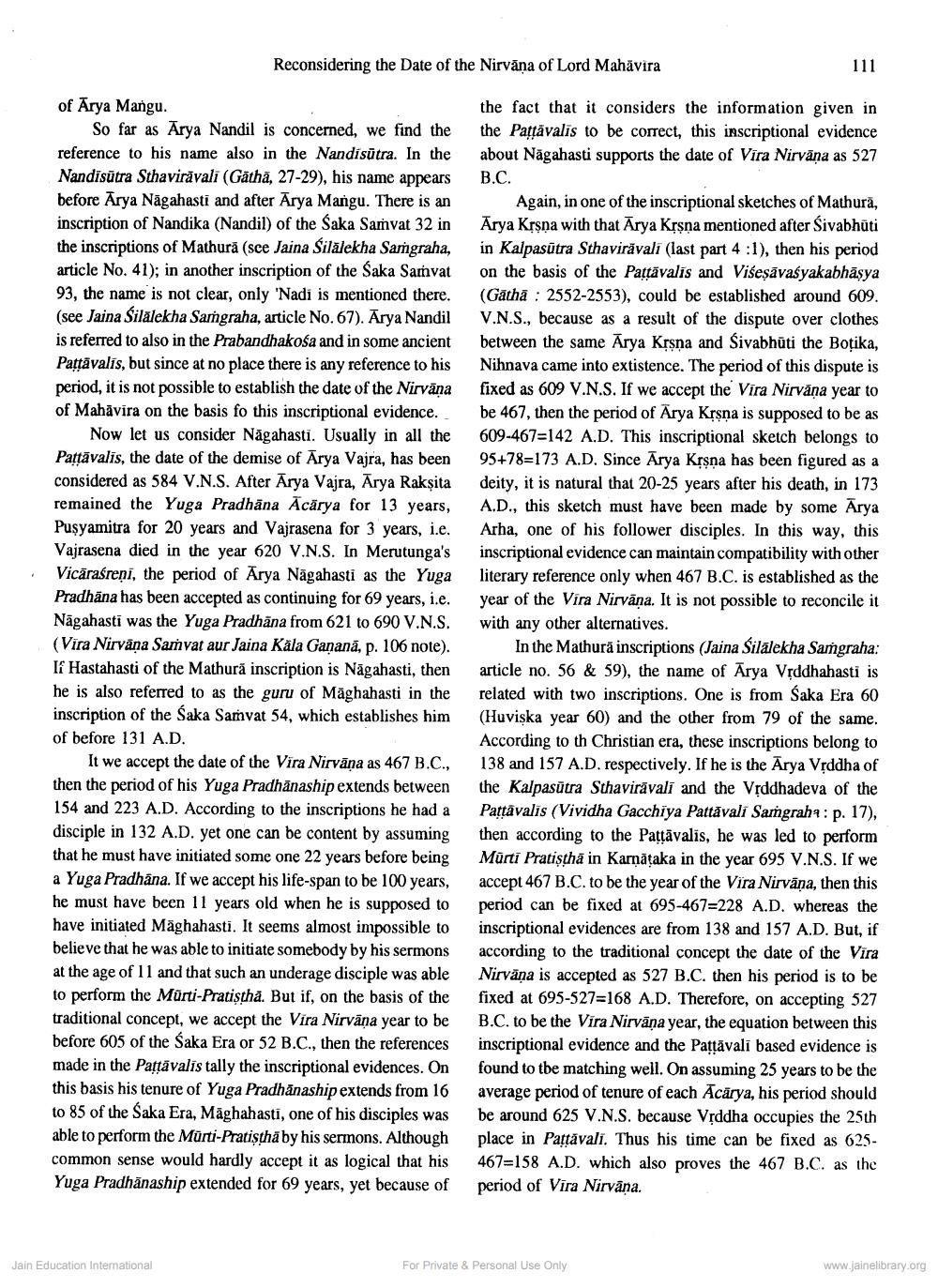Book Title: Reconsidering the date of Nirvna of Lord Mahavira Author(s): Sagarmal Jain Publisher: Z_Shwetambar_Sthanakvasi_Jain_Sabha_Hirak_Jayanti_Granth_012052.pdf View full book textPage 6
________________ Reconsidering the Date of the Nirvāna of Lord Mahavira 111 of Arya Mangu. So far as Arya Nandil is concerned, we find the reference to his name also in the Nandísūtra. In the Nandisutra Sthavirāvali (Gātha, 27-29), his name appears before Arya Nägahasti and after Arya Mangu. There is an inscription of Nandika (Nandil) of the Saka Samvat 32 in the inscriptions of Mathură (sce Jaina Šilālekha Samgraha, article No. 41); in another inscription of the Saka Samvat 93, the name is not clear, only 'Nadi is mentioned there. (see Jaina Silalekha Saṁgraha, article No. 67). Arya Nandil is referred to also in the Prabandhakośa and in some ancient Pattāvalis, but since at no place there is any reference to his period, it is not possible to establish the date of the Nirvana of Mahāvira on the basis fo this inscriptional evidence. Now let us consider Nägahasti. Usually in all the Pattāvalis, the date of the demise of Arya Vajra, has been considered as 584 V.N.S. After Arya Vajra, Arya Raksita remained the Yuga Pradhāna Acārya for 13 years, Pusyamitra for 20 years and Vajrasena for 3 years, i.e. Vajrasena died in the year 620 V.N.S. In Merutunga's Vicāraśreni, the period of Arya Nāgahasti as the Yuga Pradhana has been accepted as continuing for 69 years, i.e. Nāgahasti was the Yuga Pradhana from 621 to 690 V.N.S. (Vira Nirvana Samvat aur Jaina Kala Gananā, p. 106 note). If Hastahasti of the Mathura inscription is Nägahasti, then he is also referred to as the guru of Mäghahasti in the inscription of the Saka Samvat 54, which establishes him of before 131 A.D. It we accept the date of the Vīra Nirvāna as 467 B.C. then the period of his Yuga Pradhanaship extends between 154 and 223 A.D. According to the inscriptions he had a disciple in 132 A.D. yet one can be content by assuming that he must have initiated some one 22 years before being a Yuga Pradhana. If we accept his life-span to be 100 years, he must have been 11 years old when he is supposed to have initiated Mäghahasti. It seems almost impossible to believe that he was able to initiate somebody by his sermons at the age of 11 and that such an underage disciple was able to perform the Mürti-Pratistha. But if, on the basis of the traditional concept, we accept the Vira Nirvana year to be before 605 of the Saka Era or 52 B.C., then the references made in the Pastāvalis tally the inscriptional evidences. On this basis his tenure of Yuga Pradhanaship extends from 16 to 85 of the Saka Era, Mäghahasti, one of his disciples was able to perform the Murti-Pratisthä by his sermons. Although common sense would hardly accept it as logical that his Yuga Pradhanaship extended for 69 years, yet because of the fact that it considers the information given in the Pațțävalis to be correct, this inscriptional evidence about Nägahasti supports the date of Vīra Nirvāṇa as 527 B.C. Again, in one of the inscriptional sketches of Mathura, Arya Krsna with that Ārya Krsna mentioned after Sivabhūti in Kalpasūtra Sthaviravali (last part 4 :1), then his period on the basis of the Pattāvalis and Viseșāvasyakabhāsya (Gātha : 2552-2553), could be established around 609. V.N.S., because as a result of the dispute over clothes between the same Arya Krsna and Sivabhūti the Boţika, Nihnava came into extistence. The period of this dispute is fixed as 609 V.N.S. If we accept the Vira Nirvana year to be 467, then the period of Arya Krsna is supposed to be as 609-467=142 A.D. This inscriptional sketch belongs to 95+78=173 A.D. Since Ārya Krsna has been figured as a deity, it is natural that 20-25 years after his death, in 173 A.D., this sketch must have been made by some Arya Arha, one of his follower disciples. In this way, this inscriptional evidence can maintain compatibility with other literary reference only when 467 B.C. is established as the year of the Vira Nirvana. It is not possible to reconcile it with any other alternatives. In the Mathura inscriptions (Jaina Silalekha Saṁgraha: article no. 56 & 59), the name of Arya Vrddhahasti is related with two inscriptions. One is from Saka Era 60 (Huvişka year 60) and the other from 79 of the same. According to th Christian era, these inscriptions belong to 138 and 157 A.D. respectively. If he is the Arya Vrddha of the Kalpasūtra Sthavirāvali and the Vrddhadeva of the Pattāvalis (Vividha Gacchiya Pattāvali Sangraha : p. 17), then according to the Pattāvalis, he was led to perform Mūrti Pratiștha in Karnātaka in the year 695 V.N.S. If we accept 467 B.C. to be the year of the Vira Nirvana, then this period can be fixed at 695-467=228 A.D. whereas the inscriptional evidences are from 138 and 157 A.D. But, if according to the traditional concept the date of the Vira Nirvana is accepted as 527 B.C. then his period is to be fixed at 695-527=168 A.D. Therefore, on accepting 527 B.C. to be the Vira Nirvāna year, the equation between this inscriptional evidence and the Patļāvali based evidence is found to the matching well. On assuming 25 years to be the average period of tenure of each Acarya, his period should be around 625 V.N.S. because Viddha occupies the 25th place in Pattāvali. Thus his time can be fixed as 625467=158 A.D. which also proves the 467 B.C. as the period of Vira Nirvana. Jain Education International For Private & Personal Use Only www.jainelibrary.orgPage Navigation
1 ... 4 5 6 7 8
